From Grant to Whitnall, these parks in Milwaukee County are natural gems
There’s a saying in the world of outdoor recreation that the best destination is the one in your backyard.
Indeed, some of my favorite spots are ones that are easy to get to — the trails along the Milwaukee River, where I spent many a pandemic lunch hour; the Oak Leaf Trail, a paved paradise for long bike rides; the prairie trails at Lapham Peak, perfect for a long hike any time of year.
Milwaukee might have a reputation as a blue-collar city, but its green roots run deep, with a multitude of natural gems tucked into every corner of a county split by three rivers along a Great Lake.
With 249 public parks, 90% of residents live within a 10-minute walk of a park, according to the Trust for Public Land.
It’s easy to take those green spaces for granted and instead hit the road for flashier destinations like Devil’s Lake.
But if you don't have time for a road trip or want a dose of nature closer to home, there are plenty of natural spots to explore here. Some are representative of the natural landscape that existed here before European settlement; some are home to a diversity of wildlife; many have pockets where you forget you’re in the city.
Here are some of those natural gems to explore in Milwaukee County.
Lake Michigan parks
It’s easy to forget what a gem we have in having a Great Lake in our backyard. A string of parks provides access to that gem and the beaches and bluffs along it, stretching from Doctors Park in Fox Point to Bender Park in Oak Creek.
Among them are Veterans Park and Lakeshore State Park in the heart of downtown, favorites for both visitors and locals for easy strolls, jogs, picnics, kite flying, bike rides, paddles on the lagoon and photo opportunities. And there's Bradford Beach to the north, with free beach wheelchairs and a mobi mat allowing more people to access it. The paved Oak Leaf Trail connects all of them.
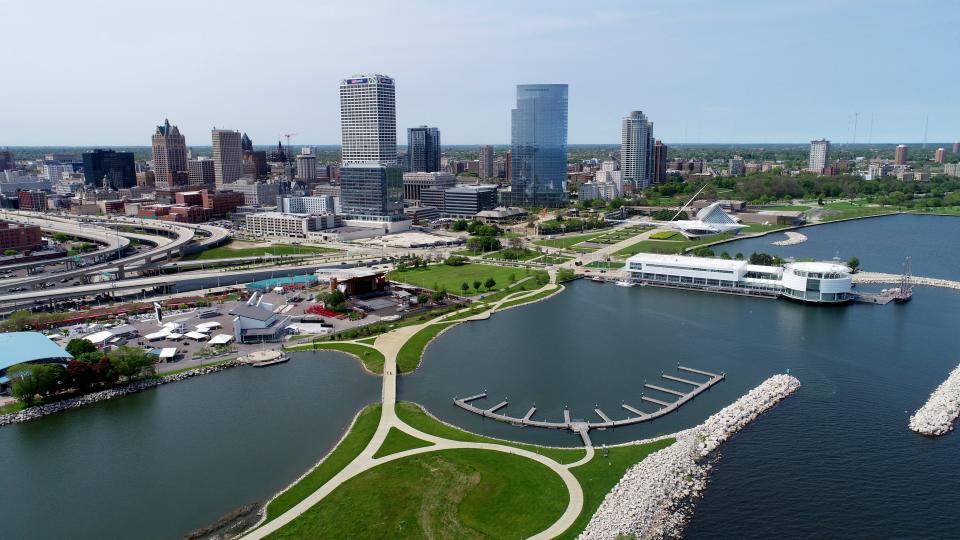
There’s not much natural about the parks — they’re all essentially landfills, created with debris from highway and other construction projects. And Lakeshore’s 22 acres of prairie is more representative of landscapes farther inland; the land along the lakefront was mostly wetlands lined by steep bluffs before it was developed.
Still, it’s a beautiful spot in the heart of Milwaukee, and there’s something special about having so much public greenspace along the lake. You won’t forget you’re in the city, but rather feel like you’re seeing its best side.
More information: Veterans Park is at 1010 N. Lincoln Memorial Drive; Lakeshore State Park is at 500 N Harbor Drive; Bradford Beach is at 2400 N. Lincoln Memorial Drive. All are free to visit. Leashed pets are permitted at Veterans and Lakeshore.
Grant Park
This Lake Michigan park deserves its own mention for its bluffs, beach and a terrific little trail system.
That would be the popular Seven Bridges Trail, which offers a chance for a moderate hike through wooded ravines leading to the lake. The 2-mile trail system actually has 10 bridges, beginning with a covered one that greets visitors with the inscription: “Enter this wild wood and view the haunts of nature.”
There are stories of ghostly happenings in the park, but during the day it's only hauntingly beautiful, with wooded bluffs obscuring views of any city buildings when the trees are leafed out — a particularly scenic sight in the fall.
You can thank the men of the Civilian Conservation Corps for building the foundations for many of the trails in the 1930s. Sixty years later, the Wisconsin Conservation Corps rebuilt sections that had deteriorated, including six bridges.
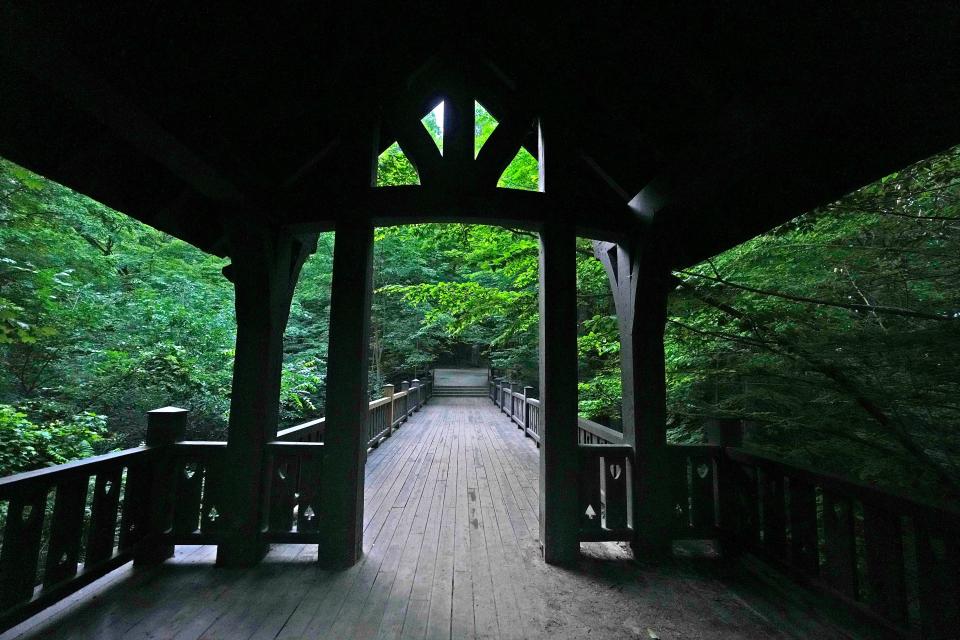
Most people stick to the 1/2-mile main loop that runs along the main creek leading to the beach, but if you head off on the 1/3-mile bluff-top trail (accessible via a staircase past the stone bench) or any other side trails, you might find solitude, even on a busy summer or fall day.
More information: Grant Park is at 100 E. Hawthorne Ave., South Milwaukee; the Seven Bridges trailhead is on Grant Park Drive on the north side of the park. The park is free to visit. Leashed pets are permitted on the trails but not on the beach.
Schlitz Audubon Nature Center
Here’s another one along the lake worth its own mention. This 185-acre nature center boasts 6 miles of trails (including a mile-long accessible loop) that wind through wetlands, woods and bluffs down to the lake; an observation tower that offers views of all that; and educational programming that includes a raptor program with 15 birds of prey from bald eagles to screech owls.
The property is home to a variety of critters from frogs and turtles to muskrats and monarchs. It's also a birdwatchers’ paradise and has been designated an Important Birding Area. More than 260 species have been spotted here, from herons and hawks to warblers and woodpeckers.

The nature center plays host to hundreds of events throughout the year, from guided hikes to Word with a Bird, a weekly meet-and-greet with the center’s raptors (1-2 p.m. Saturday and Sunday).
More information: Schlitz Audubon is at 1111 E. Brown Deer Road. The center’s trails are open 8:30 a.m.-5 p.m. daily, with extended hours in the summer (until 8 p.m. Monday-Thursday through August). Admission is $8 for adults, $5 for kids (ages 3-17) and veterans and active-duty military, and free for members ($55 for individuals, $65 for a family, $35 for students and military). Pets are not permitted.
RELATED: Schlitz Audubon celebrates 50 years of providing a place to 'find joy and solace in nature'
County Grounds Park
County Grounds is three natural gems in one, sandwiched among I-41, UW-Milwaukee's Innovation Campus and the Milwaukee Medical Regional Center in Wauwatosa.
On the west side of the park is the Monarch Trail, 22 acres of restored prairie and woods that serve as a roosting site for monarchs as they migrate from their breeding grounds in the north to their winter grounds in Mexico. A narrow trail winds through restored prairie — with plenty of milkweed for the monarchs — oak savanna and past a massive sycamore where monarchs often roost. Dogs, bikes and even jogging are not permitted — making for a truly wild trail (wear pants and bug spray and do a tick check after walking).

That’s not to say you’ll forget you’re in an urban area — traffic noise from the interstate and busy Swan Boulevard is a constant companion, and both are visible from the 1-mile trail as it snakes around an apartment complex developed around two historic Eschweiler buildings. But it’s amazing what a small natural enclave can support, from the hundreds of butterflies to the more-than-10-point buck I once spotted in the pocket of woods in the northwest corner.
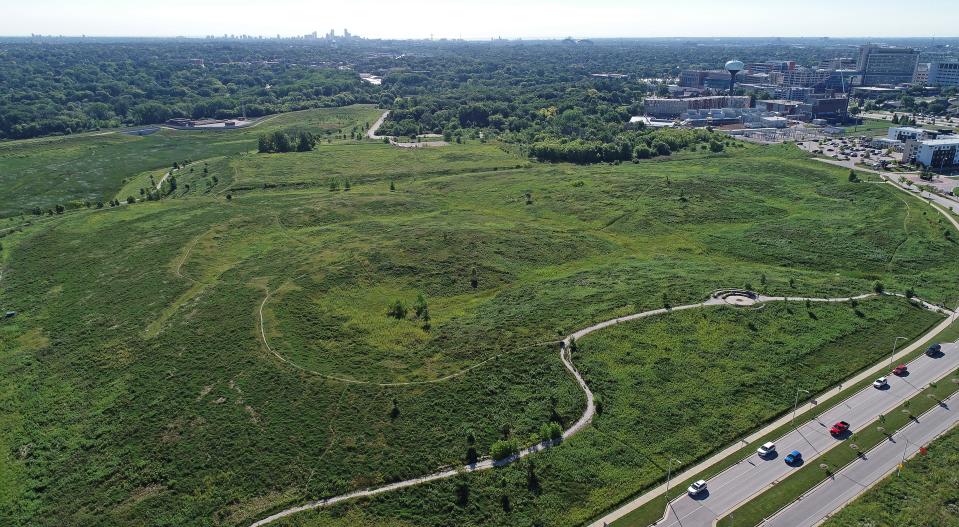
The east side offers views of the main portion of the park, featuring gently rolling hills of restored prairie. A short gravel trail off Discovery Parkway leads to an overlook of the prairie, and a network of other trails winds through it below. The prairie represents what used to be a dominant landscape in southern Wisconsin. But of the 2 million acres that covered the state before European settlement, only about 12,000 remain, according to the Wisconsin Department of Natural Resources.
Some of those trails lead to Sanctuary Woods, on the east side of County Grounds. The woods served as just that, a sanctuary, for patients in the county’s first mental health facility, which opened in 1880. Remnants of that past can be found throughout, from the stone foundation of a men’s pavilion to staircases that lead down to a ravine in what was the women’s grove (both labeled by small signs). The woods are still a sanctuary today, a forest enclave (with some old-growth trees) in the middle of the state’s most populated region.
More information: The trailhead for the Monarch Trail is on Eschweiler Drive just west of Discovery Parkway, where parking is available. Find a parking lot for Sanctuary Woods off 87th Street north of Watertown Plank Road. Pets are not permitted on the Monarch Trail, but they are allowed in the rest of the park. There are no official trail markers outside of the Monarch Trail, but there is an established network of well-trodden trails.
Milwaukee River Greenway
This is one of those spots where you might forget you’re in the city, despite being in the heart of it.
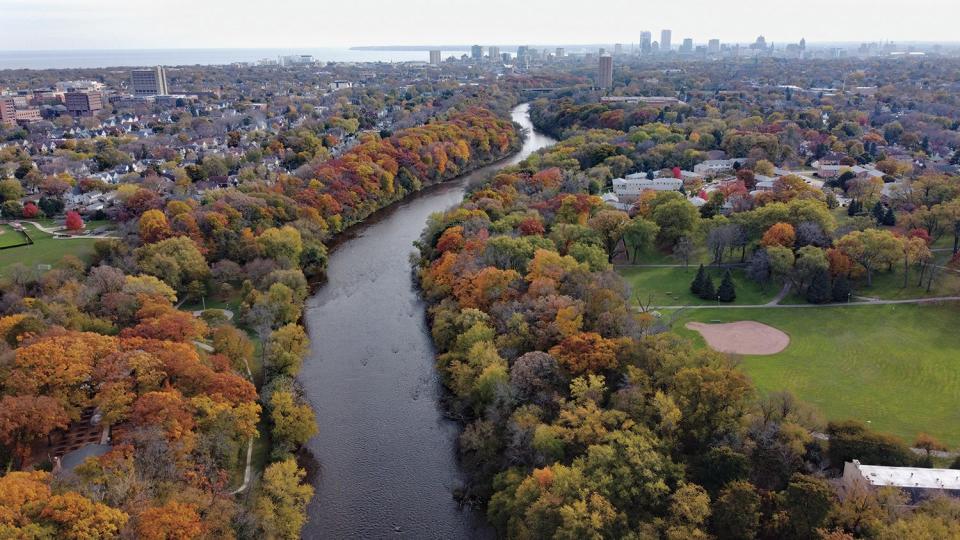
The Greenway encompasses nearly 900 acres of green space along a 6-mile stretch of the Milwaukee River, linking 12 public parks and 28 miles of hiking, biking and water trails from Caesar’s Park on the lower east side to Lincoln Park in Glendale. That’s prime access to nature and the river within a mile of downtown — a precious gem indeed.
At the beginning of the pandemic, the southern stretch from North Humboldt Avenue to East Locust Street was my oasis. Trails run along both sides of the river there, passing through wetlands and woods filled with birdsong. In some stretches, the river's steep banks obscure views of almost all city buildings.
At the northern edge of that stretch is the Urban Ecology Center’s Riverside branch. The nonprofit not only has worked to restore land along the river there but also provides community programming throughout the year and access to outdoor equipment for borrowing, including kayaks and canoes.
You can launch one of those from the canoe launch in the adjacent Milwaukee Rotary Centennial Arboretum for paddling along the Milwaukee Urban Water Trail.
More information: Access the trails along the southern stretch of the Greenway from North Riverboat Road just east of North Humboldt Avenue or Caesar's Park, 1939 N. Warren Ave. The Urban Ecology Center's Riverside branch is at 1500 E. Park Place. For more on the Greenway, see riverrevitalizationfoundation.org.
Whitnall Park
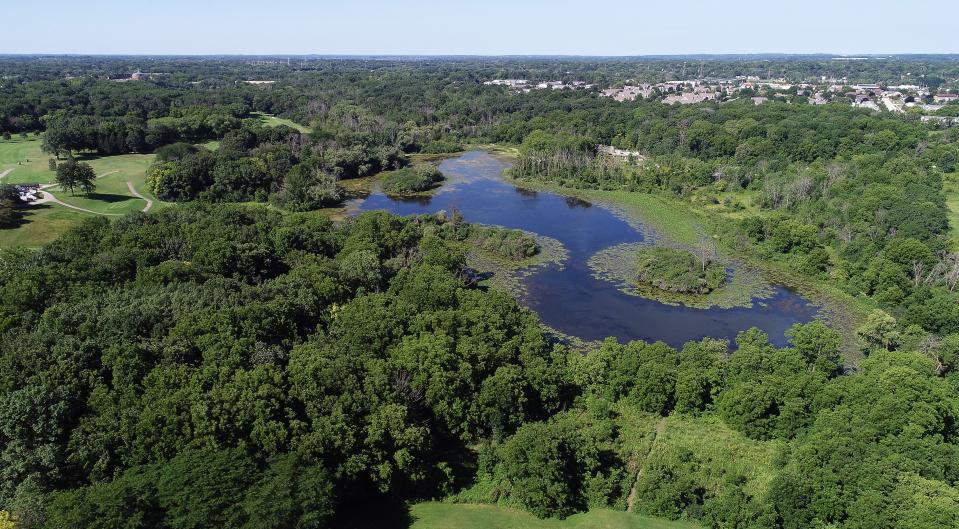
Milwaukee County’s biggest park has plenty to explore across its more than 625 acres. The golf course and beer garden aren’t natural, of course, but together with Boerner Botanical Gardens, Wehr Nature Center and the rest of the park, make Whitnall a spot you could easily spend a whole day.
Wehr is the natural core of the park, with 5 miles of trails that wind through 220 acres of woods, wetlands and prairie, and around Mallard Lake, which has a small waterfall at its northern end where it feeds the Root River.
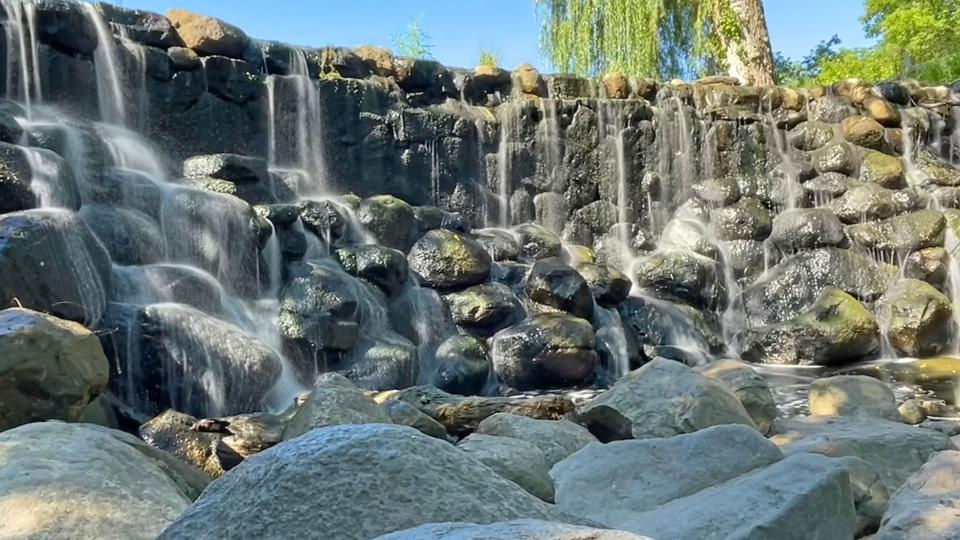
Most of the trails are relatively flat, wide and family-friendly, including a 1/3-mile accessible boardwalk and pier overlooking the lake, a 1/3-mile Sensory Trail that’s labeled as a quiet area, and an accessible family restroom with an adult changing table. The nature center also has an all-terrain wheelchair available to borrow from Access Ability Wisconsin.
The north side of the park is home to Boerner, where there’s always something blooming in warm-weather months. The garden also plays host to many events including the popular China Lights Wisconsin Festival, which returns Sept. 16-Oct. 30.
For more nature with less crowds, head to Mangan Woods, which is home to some of the largest old-growth hardwoods in the park system, according to Milwaukee County Parks. The woods, accessible next to the Ross Lodge off 92nd Street across from the golf course, are home to both hiking-only trails and multi-use trails open to off-road biking (the Kegel-Alpha trails).
More information: Whitnall Park is at 5879 S. 92 St., Franklin. Find parking in lots along Whitnall Park Drive. It’s free to visit.
Parking is also available at Wehr Nature Center but costs $4. The nature center is at 9701 W. College Ave., Franklin. The trails there are open sunrise to sunset daily; the visitor center is open 8:30 a.m.-4:30 p.m. daily. Dogs are not permitted on the Wehr trails.
Havenwoods State Forest
Wisconsin’s only urban forest is more prairie than forest, but it’s all a natural escape in the northwest corner of the city — another one of those spots where it’s easy to forget you’re in Milwaukee.
Six miles of trails wind through the 237-acre property that has an interesting past, from serving as the site for the Milwaukee County House of Corrections and an Army Disciplinary Barracks for soldiers and prisoners of war during World War II to a Nike Ajax missile base during the beginning of the Cold War.
Today the land looks closer to what it would have been before it was cleared for farming by early European settlers — primarily lowland forest. Those woods surround wetlands and prairie that are home to everything from muskrats to meadowlarks. More than 6 miles of trails wind through the park, including about 2 miles of limestone trails and paved roads open to cycling.
More information: Havenwoods is at 6141 N. Hopkins St. The forest is open 6 a.m.-8 p.m. daily and is free to visit. Pets are only permitted in certain areas of the forest; pick up a map from the nature center to see where they’re allowed.
Contact Chelsey Lewis at [email protected]. Follow her on Twitter at @chelseylew and @TravelMJS and Facebook at Journal Sentinel Travel.
Our subscribers make this reporting possible. Please consider supporting local journalism by subscribing to the Journal Sentinel at jsonline.com/deal.
DOWNLOAD THE APP: Get the latest news, sports and more
This article originally appeared on Milwaukee Journal Sentinel: From Grant to Whitnall, Milwaukee County parks are natural gems
